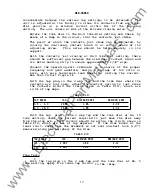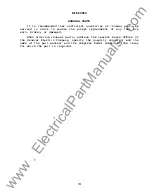
GEK-34054
APPLICATION
Time overcurrent relays are used extensivel y for the protection
of utility and industrial distribution systems, and frequentl y for
overload backup protection at other locations
o
Their very-inverse
time-current
characteristic
makes
these
re lays
well
s uited
for
application
in
locations
where
the
fault-current
magnitude
is
dependent mainly upon the location of the fault rel ative to the rel ay
and only slightly upon the system generating setup at the time of the
fault
o
Use of relays having the very-inverse characteristic in this
s ituat i on wi ll usually result· in faster clearing times than if the
inverse relay were used.
The general practice is to use a set of two or three rel ays for
interphase faults and a separate relay,
residually connected, for
single-phase-to-ground
faults.
Typical
connections
for
such
an
applicat i on are shown in Figure 15.
Use of a separate ground relay
is advantageous because it can be ad justed to provide more sensitive
protection on ground faults.
In the application of these relays
with
automatic recl osing
devices, the reset time should be considered.
The reset time of all
IAC53 and IAC54 relays covered by these instructions is approximately
60 seconds, from the fully closed to the fully open position, when
set at the number 10 time dial.
When setting these relays to coordinate with ''downstream" relays,
a
coordination time
of
from 0.25 to .040 seconds
is
generally
allowed,
depending on the clearing time of the breaker invol ved.
These coordination times include,
in addition to breaker-cl earing
time, 0. 10 second for relay overt ravel and 0 ol7 second for safety
factor.
For example, if the breaker-clearing time is 0.13 second ( 8
cycles ) , the coordination time would be 0. 40 second.
If the rel ay
time 1s set by test at the current level in question, the safety
factor may be reduced from 0.1 7 to 0 o 07 second.
Then, with relay
overtravel of
. 10
second,
if the "downstream" breaker time is 5
cycles (0.08 seconds ) a minimum of Oo25 seconds could be al l owed for
coordination.
CONSTRUCTION
The induction unit is the basic unit in all Type IAC relays.
Figures 3 and 4 s how the induction unit mounted in the cradle.
These
units are of the induction-disk -construction type.
The disk is
actuated by a current-operating coil on a l aminated U-magnet.
The
disk s haft carries the moving contact that completes the alarm or
trip circuit when it touches the stationary contact or contacts.
The
disk shaft is restrained by a spiral spring to give the proper
contact-closing current, and its motion is retarded by a permanent
magnet acting on the disk to give the correct time delay.
There i s a target and seal-in unit mounted on the front, to the
left o f the shaft of the time-overcurrent unit.
The seal-in unit has
its coil in series and its contacts in parallel with the contacts of
the time-overcurrent uni t, such that when the induction-unit contacts
cl ose, the seal -in unit picks up and seals in.
When the seal -in unit
4
www
. ElectricalPartManuals
. com







































